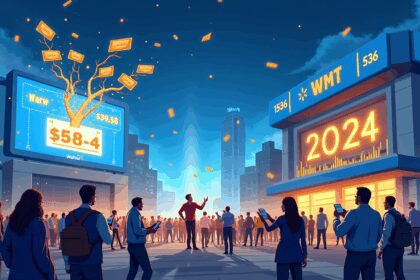The term “nillionaire” represents individuals with little to no net worth, positioning them as the direct opposite of millionaires who possess at least $1 million in assets.
This clever linguistic creation has evolved beyond a simple descriptor to become a cultural identifier for the millions worldwide who struggle with negative net worth, debt burdens, and minimal financial assets despite often holding jobs and participating in the economy.
Key Takeaways
- Nillionaires represent the bottom half of global wealth distribution, with approximately 40% of adults worldwide possessing less than $10,000 in assets while collectively owning just 1.3% of total global wealth.
- COVID-19 dramatically widened the wealth gap, with billionaires gaining $3.9 trillion while global workers lost $3.7 trillion in combined income during the pandemic.
- The nillionaire identity has become a social phenomenon, creating online communities where people use humor and shared experiences to discuss financial struggles without shame or stigma.
- Geographic income disparities intensify nillionaire challenges, with average monthly incomes ranging from €240 in Sub-Saharan Africa to much higher amounts in developed regions, affecting access to basic necessities.
- Systemic factors rather than personal failures often trap people in nillionaire status, as economic structures favor asset owners over wage earners during both normal times and crises.
Rising Inequality and Limited Wealth Access
Understanding nillionaire status reveals stark realities about modern economic inequality. The statistics paint a clear picture: while the wealthy accumulate assets at unprecedented rates, vast populations remain trapped in cycles of minimal wealth accumulation. These patterns have accelerated dramatically since the pandemic began.
Financial institutions and economic policies consistently favor those who already possess substantial assets. Interest rates benefit borrowers with good credit and substantial collateral. Investment opportunities require minimum balances that exclude most nillionaires from participation. Tax structures often burden wage earners more heavily than capital gains recipients.
A New Cultural Narrative
Social media platforms have transformed how nillionaires view their circumstances. People share stories, strategies, and solidarity through hashtags and forums dedicated to financial transparency. This movement challenges traditional shame around money struggles and builds communities based on shared economic realities.
Some communities even use humor to reclaim their financial identity. Memes and hashtags such as #nillionaire allow users to find solidarity and validation through honesty about their struggles with debt, rent, and lack of savings.
The Geographic Divide
Geographic location significantly impacts nillionaire experiences. Someone earning €500 monthly in Eastern Europe faces different challenges than someone earning the same amount in Western European capitals. Cost of living variations create vastly different standards of living despite similar nominal incomes.
Education and the Wealth Gap
Educational systems rarely prepare individuals for wealth-building strategies that transcend traditional employment. Schools focus on job preparation rather than asset accumulation, leaving many unprepared for economic systems that reward ownership over labor. This knowledge gap perpetuates generational wealth disparities.
Beyond the Individual: Systemic Change
The nillionaire phenomenon reflects broader systemic issues rather than individual shortcomings. Economic structures that concentrate wealth among asset holders create barriers for those starting with little or no capital. Addressing these patterns requires understanding both personal strategies and systemic changes needed for broader economic equity.
From Zero Net Worth to Global Phenomenon: Understanding the Nillionaire Identity
The term “nillionaire” represents a clever linguistic creation that captures the financial reality millions of people face worldwide. This invented word describes individuals with little to no net worth or zero financial assets, positioning them as the conceptual opposite of those who’ve achieved millionaire status. While millionaires possess at least $1 million in net worth, nillionaires find themselves at the other end of the spectrum, often struggling with debt, minimal savings, or assets that barely register on traditional wealth measurements.
The contrast becomes even starker when considering billionaires in this equation. I find the scale comparison particularly striking: one million seconds equals approximately 11 days, while one billion seconds stretches across roughly 31 years. This mathematical perspective illustrates the enormous gulf between different wealth categories and helps contextualize where nillionaires sit within this framework.
The Growing Recognition of Financial Disparity
Modern economic discussions increasingly acknowledge the widening gap between the wealthy and those with minimal assets. Nillionaires aren’t necessarily unemployed or homeless—many hold jobs, rent apartments, and participate in the economy despite having negative or near-zero net worth. Student loans, credit card debt, and limited savings opportunities often keep individuals in this category regardless of their income levels.
Understanding the nillionaire identity helps frame important conversations about wealth inequality and financial accessibility. While some people explore hidden ways to save money or monitor global equity markets, nillionaires typically focus on basic financial survival rather than wealth accumulation strategies.
The term also highlights how traditional financial advice often misses the mark for those starting from zero or negative positions:
- Investment recommendations assume disposable income that many nillionaires simply don’t possess.
- Credit building becomes a primary concern rather than portfolio diversification.
- Emergency funds remain aspirational goals rather than practical realities.
Social media has amplified awareness of the nillionaire experience, with many people openly discussing their financial struggles and zero-wealth status. This transparency challenges previous taboos around money discussions and creates communities of support among those facing similar circumstances. The nillionaire identity has evolved from a simple descriptor into a rallying point for financial honesty and systemic change advocacy.

The Shocking Reality of Global Wealth Distribution
I’ve witnessed firsthand how discussions about wealth inequality often focus on millionaires and billionaires, but the true scope of financial disparity becomes clear when examining where most people actually stand. The Credit Suisse Global Wealth Report reveals numbers that highlight just how precarious the financial situation is for the majority of adults worldwide.
The Bottom Half’s Minimal Share
The statistics paint a stark picture of wealth concentration. According to the Credit Suisse Global Wealth Report, the bottom half of the world’s adult population owns just 1.3% of total global wealth. This means billions of people collectively control less wealth than what many single corporations possess. Approximately 40% of the population has less than $10,000 in assets, placing them firmly in nillionaire territory where debt often exceeds any accumulated wealth.
These figures demonstrate why the concept of being a nillionaire isn’t just theoretical — it’s the lived reality for nearly half of all adults globally. When someone struggles to build any meaningful financial foundation, they’re experiencing what characterizes this opposite end of the wealth spectrum from millionaires.
Extreme Concentration at the Top
The contrast becomes even more pronounced when examining wealth concentration among the affluent. The richest 1.1% of the population holds a staggering 45.8% of global wealth, while the top 10% controls 74% of all wealth. This leaves the remaining 90% of people to share just 26% of total global assets.
I find these disparities particularly striking because they reveal how hidden financial strategies that work for the wealthy often remain inaccessible to those in lower wealth brackets. The mathematical reality shows that for every dollar the bottom half collectively owns, the top 1% possesses roughly $35.
This concentration creates a pyramid structure where nillionaires occupy the broad base, struggling with negative net worth or minimal assets. Meanwhile, millionaires and billionaires sit at the narrow apex, controlling the vast majority of global resources. The gap between these positions isn’t just substantial — it’s grown consistently wider over recent decades.
The stark imbalance underscores the marginal financial position of nillionaires, who typically fall into the bottom half of the wealth pyramid. Many face circumstances where student loans, credit card debt, or mortgages exceed their total assets, creating the negative net worth that defines this financial category. Unlike millionaires who can leverage wealth to generate more wealth, nillionaires often find themselves trapped in cycles where debt service prevents meaningful asset accumulation.
These patterns persist across different countries and economic systems, suggesting that wealth concentration isn’t simply a regional phenomenon but a global structural reality. The data reveals that being a nillionaire isn’t about personal failure or lack of ambition — it’s about operating within economic systems where wealth naturally flows upward to those who already possess significant assets.
Understanding these distributions helps explain why traditional wealth-building advice often falls short for nillionaires. Strategies that assume disposable income or existing assets simply don’t apply when someone’s financial starting point involves overcoming debt rather than building upon savings. The gulf between nillionaire and millionaire status represents not just different amounts of money, but entirely different financial realities and possibilities.
Life as a Nillionaire: The Daily Financial Struggle
I observe that nillionaires face an entirely different reality from their millionaire counterparts, often wrestling with negative net worth rather than building wealth. Student loans, credit card debt, and the absence of property ownership create a financial hole that deepens with each passing month. These individuals carry the weight of obligations that exceed their assets, making every financial decision a careful calculation of necessity versus impossibility.
Income Disparities and Regional Challenges
The numbers paint a stark picture of global financial inequality. While the average monthly income sits around €1,065 worldwide, this figure masks dramatic regional variations that define daily survival for millions. In Sub-Saharan Africa, monthly incomes plummet to just €240, creating conditions where basic needs consume entire paychecks.
I notice these low incomes create cascading effects that extend far beyond simple budget constraints:
- Limited access to quality education restricts future earning potential
- Healthcare becomes a luxury rather than a fundamental right
- Basic necessities like nutritious food and safe housing remain out of reach
- Transportation options limit job opportunities and economic mobility
- Financial services become inaccessible due to minimum balance requirements
These financial constraints trap nillionaires in persistent cycles of poverty. Each emergency becomes a potential catastrophe since there’s no safety net to cushion unexpected expenses. A broken car, medical bill, or temporary job loss can push someone deeper into debt, making recovery increasingly difficult.
Planning for retirement becomes an abstract concept rather than a practical goal. When every dollar earned must address immediate needs, setting aside money for future security feels impossible. This reality creates a perpetual present-tense existence where long-term financial planning takes a backseat to daily survival.
The psychological toll of constant financial pressure compounds these practical challenges. Stress from money worries affects decision-making abilities, health outcomes, and personal relationships. Sleep suffers, productivity declines, and the mental energy required to escape poverty gets depleted by the very act of managing poverty itself.
I recognize that understanding these hidden ways to save money becomes crucial for nillionaires seeking any form of financial relief. Even small adjustments can provide breathing room in otherwise suffocating budgets. However, the structural nature of poverty means individual solutions can only go so far without broader economic changes that address systemic inequality and provide genuine opportunities for financial advancement.
How COVID-19 Widened the Nillionaire-Billionaire Gap
The pandemic created an unprecedented economic divide that pushed more people into nillionaire status while simultaneously enriching the world’s wealthiest individuals. This stark contrast reveals how economic crises don’t affect everyone equally – they often amplify existing inequalities in dramatic ways.
The Numbers Tell a Devastating Story
During COVID-19, billionaire wealth surged by $3.9 trillion while global workers experienced a combined income loss of $3.7 trillion. These figures demonstrate how the same economic event can produce completely opposite outcomes depending on one’s starting position. Billionaires benefited from asset price inflation, particularly in technology stocks and real estate, while millions of workers lost jobs, hours, or entire businesses.
The pandemic didn’t create wealth inequality – it acted as an accelerator for existing disparities. Those with substantial assets saw their portfolios grow as central banks pumped money into financial markets. Meanwhile, service workers, small business owners, and gig economy participants watched their income streams dry up almost overnight. Many people who considered themselves financially stable suddenly found themselves facing money-saving challenges they’d never anticipated.
How Systemic Factors Created the Perfect Storm
The pandemic exposed how economic systems favor asset owners over wage earners during times of crisis. Central bank policies designed to stabilize economies primarily benefited those who already owned stocks, bonds, and real estate. These monetary interventions inflated asset prices while doing little to directly support workers who lost employment.
Essential workers faced a particularly cruel irony – they kept the economy running while often earning poverty wages and risking their health. Many of these frontline workers discovered that being “essential” didn’t translate to being financially secure. The disconnect between economic importance and financial reward became glaringly obvious as grocery clerks, delivery drivers, and healthcare workers struggled to make ends meet while tech billionaires saw their wealth multiply.
The shift accelerated trends that were already reshaping the economy:
- Automation gained momentum as businesses looked to reduce labor costs and health risks.
- Digital platforms consolidated market power as consumers moved online.
These changes benefited platform owners and technology investors while displacing traditional workers and small businesses.
Government responses varied widely, but many safety nets proved inadequate for the scale of the crisis. While some countries provided substantial support to workers and businesses, others left people to fend for themselves. The variation in support systems highlighted how policy choices can either mitigate or exacerbate wealth inequality during economic shocks.
The pandemic also revealed how financial literacy gaps contribute to the nillionaire phenomenon. Many people lacked the knowledge or resources to protect their finances during the crisis. They didn’t understand how to:
- Access available support programs
- Restructure debt
- Pivot their income sources
This knowledge gap often determined whether someone weathered the storm or slipped into financial ruin.
Geographic disparities became more pronounced as well. Urban service economies collapsed while suburban and rural areas with lower living costs sometimes fared better. Remote work opportunities concentrated among higher-educated workers, leaving behind those in location-dependent jobs. These patterns reinforced existing divisions between economic winners and losers.
The recovery phase has continued these trends. As economies reopened, asset prices remained elevated while wage growth lagged behind inflation. Many businesses that survived did so by cutting costs and increasing efficiency, often through technology adoption that reduced their need for workers. The result is an economy that can appear healthy on paper while leaving more people behind financially than before the pandemic.
Looking at these developments, it becomes clear that the nillionaire-billionaire gap isn’t just about individual choices or circumstances. Systemic factors – from monetary policy to labor market structures to social safety nets – play crucial roles in determining who thrives and who struggles during economic upheavals. The pandemic simply made these usually invisible mechanisms impossible to ignore.

The Social Identity of Being a Nillionaire
I’ve observed how the term “nillionaire” has evolved into more than just a clever play on words. This identity serves as a cultural touchstone that reflects society’s growing awareness of economic inequality. People adopt this label with a mixture of humor and resignation, creating a shared language around financial struggle that previous generations might have kept private.
The term appears across social media platforms with remarkable frequency, often accompanied by memes that highlight the absurdity of living paycheck to paycheck in an era of unprecedented wealth concentration. I notice how individuals use “nillionaire” as a badge that acknowledges their situation without demanding pity. This self-deprecating approach allows people to maintain dignity while discussing financial hardship, transforming what could be shame into shared experience.
Cultural Recognition and Digital Expression
Online communities have embraced the nillionaire identity as a form of social commentary. Platform users share stories about choosing between groceries and gas, celebrating small financial victories like finding a forgotten twenty-dollar bill, or joking about their “vast fortune” of loose change. These narratives create solidarity among people facing similar challenges while highlighting the stark contrast with traditional wealth narratives.
The humor embedded in nillionaire culture serves multiple purposes:
- It provides emotional relief from financial stress through shared laughter
- It creates community among people experiencing similar economic pressures
- It offers subtle criticism of extreme wealth inequality without direct confrontation
- It allows individuals to discuss money problems without appearing to complain
This digital expression has democratized conversations about money that were once considered taboo. I see how people use the nillionaire identity to process their relationship with money management and economic reality in ways that feel authentic rather than performative.
The social recognition of being a nillionaire extends beyond individual experience into broader cultural commentary. Society increasingly acknowledges that financial struggle doesn’t necessarily indicate personal failure but rather reflects systemic issues affecting large populations. This shift in perspective helps reduce some stigma traditionally associated with having limited resources.
However, the nillionaire identity isn’t without complications. While humor and community provide support, the label can also reinforce class divisions by creating an “us versus them” mentality. Some individuals worry that embracing this identity might normalize financial hardship rather than motivating change. Others find that constantly joking about money problems can become emotionally exhausting over time.
The stigma associated with financial hardship persists despite cultural shifts. People identifying as nillionaires still face judgment in professional settings, social situations, and even family gatherings where economic status becomes apparent. The pressure to maintain appearances while managing limited resources creates additional stress that wealthy individuals rarely consider.
I’ve noticed how the nillionaire identity intersects with other social factors like age, education, and geographic location. Young professionals with college degrees who identify as nillionaires challenge traditional assumptions about success and financial security. Their stories highlight how economic trends have shifted expectations about career progression and wealth accumulation.
The term has also influenced how financial institutions and employers approach their messaging. Companies increasingly recognize that significant portions of their audience identify more closely with nillionaire experiences than traditional wealth-building narratives. This awareness shapes everything from marketing campaigns to employee benefit packages.
Social media algorithms have amplified nillionaire content, creating feedback loops that both validate and potentially perpetuate this identity. People discover they’re not alone in their financial struggles, but they also become immersed in content that reinforces economic anxiety. This digital environment shapes how individuals understand their place in the economic hierarchy.
The nillionaire identity represents a complex social phenomenon that combines humor, community, and economic commentary. While it provides valuable emotional support and cultural recognition for widespread financial challenges, it also reflects deeper systemic issues that require attention beyond social media acknowledgment. Understanding this identity helps illuminate how people adapt to economic realities while maintaining dignity and finding connection with others facing similar circumstances.

Nillionaire vs. Millionaire vs. Billionaire: The Ultimate Comparison
The stark contrast between these three wealth categories reveals the immense spectrum of financial standing in today’s economy. Nillionaires typically possess less than $10,000 in total assets, frequently carrying negative balances due to outstanding debts and loans. This places them at the opposite end of the wealth scale from millionaires, who control $1 million or more in net worth, and billionaires, who command assets exceeding $1 billion.
From a global wealth distribution perspective, the disparity becomes even more pronounced. Nillionaires collectively hold approximately 1% or less of total global wealth, representing the vast majority of the world’s population. Meanwhile, millionaires and billionaires comprise the elite top 1% who control an astounding 47.5% of all global wealth, according to wealth distribution studies.
Lifestyle and Financial Realities
Daily life experiences differ dramatically across these wealth tiers. Nillionaires frequently struggle with financial insecurity, managing debt payments, and making difficult choices about basic necessities. They often rely on hidden money-saving strategies just to maintain their current lifestyle while working to improve their financial position.
Millionaires enjoy considerable comfort and financial stability, with sufficient resources to weather economic downturns and invest in opportunities. They can afford quality education, healthcare, and housing without compromising their long-term financial security. Their wealth provides freedom from immediate financial stress while enabling strategic planning for future generations.
Billionaires operate in an entirely different sphere, wielding immense financial power that extends far beyond personal comfort. Their wealth creates global influence, allowing them to shape markets, fund large-scale initiatives, and impact economic policies. They can invest in emerging technologies, start foundations, and make decisions that affect entire industries.
The gap between these categories continues to widen as market trends often favor those with existing capital to invest. While nillionaires work to climb out of debt and build basic savings, millionaires and billionaires can leverage their resources to generate passive income and compound their wealth exponentially.
Understanding these distinctions helps illuminate why financial literacy and strategic planning become increasingly important for those starting from lower wealth positions. The journey from nillionaire to millionaire requires different approaches than maintaining or growing existing substantial wealth.

Sources:
Credit Suisse Global Wealth Report


